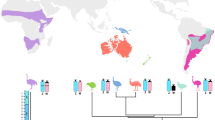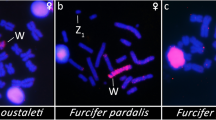Abstract
To clarify the process of avian sex chromosome differentiation in palaeognathous birds, we performed molecular and cytogenetic characterization of W chromosome-specific repetitive DNA sequences for elegant crested tinamou (Eudromia elegans, Tinamiformes) and constructed comparative cytogenetic maps of the Z and W chromosomes with nine chicken Z-linked gene homologues for E. elegans and ostrich (Struthio camelus, Struthioniformes). A novel family of W-specific repetitive sequences isolated from E. elegans was found to be composed of guanine- and cytosine-rich 293-bp elements that were tandemly arrayed in the genome as satellite DNA. No nucleotide sequence homologies were found for the Struthioniformes and neognathous birds. The comparative cytogenetic maps of the Z and W chromosomes of E. elegans and S. camelus revealed that there are partial deletions in the proximal regions of the W chromosomes in the two species, and the W chromosome is more differentiated in E. elegans than in S. camelus. These results suggest that a deletion firstly occurred in the proximal region close to the centromere of the acrocentric proto-W chromosome and advanced toward the distal region. In E. elegans, the W-specific repeated sequence elements were amplified site-specifically after deletion of a large part of the W chromosome occurred.










Similar content being viewed by others
References
Ansari HA, Takagi N, Sasaki M (1988) Morphological differentiation of sex chromosomes in three species of ratite birds. Cytogenet Cell Genet 47:185–188
Cracraft J (2001) Avian evolution, Gondwana biogeography and the Cretaceous-Tertiary mass extinction event. Proc R Soc Lond B 268:459–469
de Boer LEM (1980) Do the chromosomes of the kiwi provide evidence for a monophyletic origin of the ratites? Nature 287:84–85
de Kloet SR (2002) Molecular sex identification of tinamous with PCR using primers derived from the spindlin gene. Mol Ecol Notes 2:465–466
de Kloet RS, de Kloet SR (2003) Evolution of the spindlin gene in birds: independent cessation of the recombination of sex chromosomes at the spindlin locus in neognathous birds and tinamous, a palaeognathous avian family. Genetica 119:333–342
Ellegren H (1996) First gene on the avian W chromosome (CHD) provides a tag for universal sexing of non-ratite birds. Proc R Soc Lond B 263:1635–1641
Fridolfsson A-K, Ellegren H (1999) A simple and universal method for molecular sexing of non-ratite birds. J Avian Biol 30:116–121
García-Moreno J, Mindell DP (2000) Rooting a phylogeny with homologous genes on opposite sex chromosomes (gametologs): a case study using avian CHD. Mol Biol Evol 17:1826–1832
Griffiths R, Holland PWH (1990) A novel avian W chromosome DNA repeat sequence in the lesser black-backed gull (Larus fuscus). Chromosoma 99:243–250
Griffiths R, Daan S, Dijkstra C (1996) Sex identification in birds using two CHD genes. Proc R Soc Lond B 263:1251–1256
Griffiths R, Double MC, Orr K, Dawson RJG (1998) A DNA test to sex most birds. Mol Ecol 7:1071–1075
Handley L-JL, Ceplitis H, Ellegren H (2004) Evolutionary strata on the chicken Z chromosome: implications for sex chromosome evolution. Genetics 167:367–376
Hori T, Asakawa S, Itoh Y, Shimizu N, Mizuno S (2000) Wpkci, encoding an altered form of PKCI, is conserved widely on the avian W chromosome and expressed in early female embryos: implication of its role in female sex determination. Mol Biol Cell 11:3645–3660
Itoh Y, Mizuno S (2002) Molecular and cytological characterization of SspI-family repetitive sequence on the chicken W chromosome. Chromosome Res 10:499–511
Kodama H, Saitoh H, Tone M, Kuhara S, Sakaki Y, Mizuno S (1987) Nucleotide sequences and unusual electrophoretic behavior of the W chromosome-specific repeating DNA units of the domestic fowl, Gallus gallus domesticus. Chromosoma 96:18–25
Matsuda Y, Chapman VM (1995) Application of fluorescence in situ hybridization in genome analysis of the mouse. Electrophoresis 16:261–272
Matsuda Y, Nishida-Umehara C, Tarui H, Kuroiwa A, Yamada K, Isobe T, Ando J, Fujiwara A, Hirao Y, Nishimura O, Ishijima J, Hayashi A, Saito T, Murakami T, Murakami Y, Kuratani S, Agata K (2005) Highly conserved linkage homology between birds and turtles: Birds and turtle chromosomes are precise counterparts of each other. Chromosome Res 13:601–615
Nishida-Umehara C, Fujiwara A, Ogawa A, Mizuno S, Abe S, Yoshida MC (1999) Differentiation of Z and W chromosomes revealed by replication banding and FISH mapping of sex-chromosome-linked DNA markers in the cassowary (Aves, Ratitae). Chromosome Res 7:635–640
Ogawa A, Murata K, Mizuno S (1998) The location of Z- and W-linked marker genes and sequence on the homomorphic sex chromosomes of the ostrich and the emu. Proc Natl Acad Sci USA 95:4415–4418
O’Neill M, Binder M, Smith C, Andrews J, Reed K, Smith M, Millar C, Lambert D, Sinclair A (2000) ASW: a gene with conserved avian W-linkage and female specific expression in chick embryonic gonad. Dev Genes Evol 210:243–249
Pigozzi MI, Solari AJ (1997) Extreme axial equalization and wide distribution of recombination nodules in the primitive ZW pair of Rhea americana (Aves, Ratitae). Chromosome Res 5:421–428
Pigozzi MI, Solari AJ (1999) The ZW pairs of two paleognath birds from two orders show transitional stages of sex chromosome differentiation. Chromosome Res 7:541–551
Pigozzi MI, Sorali AJ (2005) Meiotic recombination in the ZW pair of a tinamid bird shows a differential pattern compared with neognaths. Genome 48: 286–290
Saitoh Y, Mizuno S (1992) Distribution of XhoI and EcoRI family repetitive DNA sequences into separate domains in the chicken W chromosome. Chromosoma 101:474–477
Saitoh H, Harata M, Mizuno S (1989) Presence of female-specific bent-repetitive DNA sequences in the genomes of turkey and pheasant and their interactions with W-protein of chicken. Chromosoma 98:250–258
Saitoh Y, Saitoh H, Ohtomo K, Mizuno S (1991) Occupancy of the majority of DNA in the chicken W chromosome by bent-repetitive sequences. Chromosoma 101:32–40
Sasaki M, Nishida C, Takagi N, Hori H (1980) Sex-chromosomes of the elegant crested tinamou, Eudromia elegans (Aves: Tinamiformes: Tinamidae). Chromosome Inf Serv 29:19–21
Schmid M, Enderle E, Schindler D, Schempp W (1989) Chromosome banding and DNA replication patterns in bird karyotypes. Cytogenet Cell Genet 52:139–146
Shetty S, Griffin DK, Graves JAM (1999) Comparative painting reveals strong chromosome homology over 80 million years of bird evolution. Chromosome Res 7:289–295
Shetty S, Kirby P, Zarkower D, Graves JAM (2002) DMRT1 in a ratite bird: evidence for a role in sex determination and discovery of a putative regulatory element. Cytogenet Genome Res 99:245–251
Sibley CG, Ahlquist JE (1990) Phylogeny and classification of birds: a study in molecular evolution. Yale University Press, New Haven
Summer AT (1972) A simple technique for demonstrating centromeric heterochromatin. Exp Cell Res 75:304–306
Takagi N (1972) A comparative study of the chromosome replication in 6 species of birds. Jpn J Genet 47:115–123
Takagi N, Sasaki M (1974) A phylogenetic study of bird karyotypes. Chromosoma 46:91–120
Takagi N, Itoh M, Sasaki M (1972) Chromosome studies in four species of Ratitae (Aves). Chromosoma 36:281–291
Tone M, Nakano N, Takao E, Narisawa S, Mizuno S (1982) Demonstration of W chromosome-specific repetitive DNA sequences in the domestic fowl, Gallus g. domesticus. Chromosoma 86:551–569
Tone M, Sakaki Y, Hashiguchi T, Mizuno S (1984) Genus specificity and extensive methylation of the W chromosome-specific repetitive DNA sequences from the domestic fowl, Gallus gallus domesticus. Chromosoma 89:228–237
van Tuinen M, Hedges SB (2001) Calibration of avian molecular clocks. Mol Biol Evol 18:206–213
van Tuinen M, Sibley CG, Hedges SB (1998) Phylogeny and biogeography of ratite birds inferred from DNA sequences of the mitochondrial ribosomal genes. Mol Biol Evol 15:370–376
van Tuinen M, Sibley CG, Hedges SB (2000) The early history of modern birds inferred from DNA sequences of nuclear and mitochondrial ribosomal genes. Mol Biol Evol 17:451–457
Yamada K, Nishida-Umehara C, Ishijima J, Murakami T, Shibusawa M, Tsuchiya K, Tsudzuki M, Matsuda Y (2006) A novel family of repetitive DNA sequences amplified site-specifically on the W chromosomes in Neognathous birds. Chromosome Res 14:613–627
Acknowledgements
We express our appreciation to Yokohama Zoological Gardens, Yokohama, for providing skin and blood samples of elegant crested tinamou, and Kimiyuki Tsuchiya for skin samples of ostrich. This work was supported by Grants-in-Aid for Scientific Research (nos. 15370001 and 16086201) from the Ministry of Education, Culture, Sports, Science and Technology, Japan.
Author information
Authors and Affiliations
Corresponding author
Additional information
Communicated by Y. Hiraoka
Rights and permissions
About this article
Cite this article
Tsuda, Y., Nishida-Umehara, C., Ishijima, J. et al. Comparison of the Z and W sex chromosomal architectures in elegant crested tinamou (Eudromia elegans) and ostrich (Struthio camelus) and the process of sex chromosome differentiation in palaeognathous birds. Chromosoma 116, 159–173 (2007). https://doi.org/10.1007/s00412-006-0088-y
Received:
Revised:
Accepted:
Published:
Issue Date:
DOI: https://doi.org/10.1007/s00412-006-0088-y




